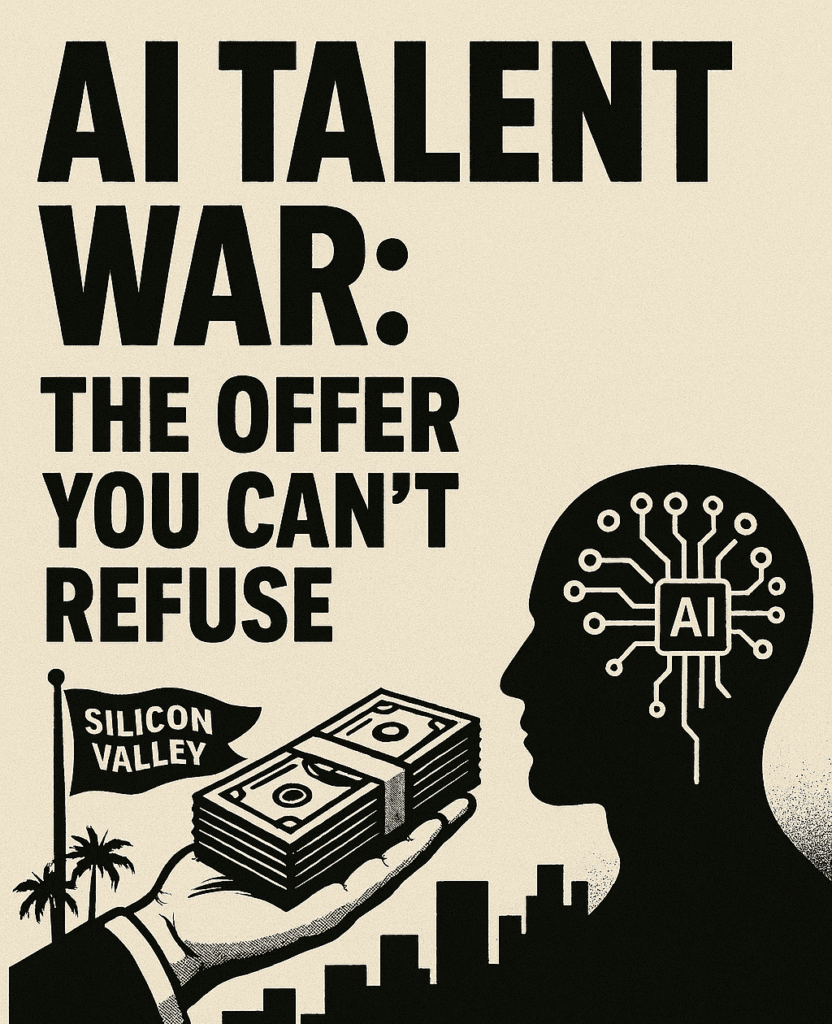By The Milk News Desk
Silicon Valley – August 22, 2025
Silicon Valley is no stranger to high-stakes battles, but the latest war brewing here isn’t fought with code or patents—it’s fought with cash, ambition, and the sharpest minds in artificial intelligence. Welcome to the AI Talent War, where nine-figure signing bonuses are the new normal, and companies are literally betting their futures on securing the brightest brains in the game.

The Spending Frenzy: When Money Talks, Everyone Listens
Mark Zuckerberg, the man who once burned $46 billion on the metaverse, is at it again—but this time, his bet is on AI, and it’s bigger, bolder, and riskier than ever. Meta is offering eye-watering compensation packages to attract top AI researchers, including reported $100 million signing bonuses for elite engineers. The goal? To staff its newly formed Superintelligence Labs, a project so ambitious it aims to deliver “personal superintelligence to everyone in the world.” But it’s not just about the money. Zuckerberg’s strategy also includes building massive data centers and groundbreaking infrastructure, like the Hyperion facility, which will scale up to five gigawatts of power—enough to rival Manhattan’s energy footprint. It’s clear Meta isn’t messing around; this is a race for technological dominance, with talent density and computational resources as the strategic weapons of choice.
The Rivalries: When Giants Clash
Meta isn’t the only player in this game. Microsoft is flexing its muscles too, with internal documents revealing a “most-wanted list” of Meta engineers and researchers. Microsoft has even developed a new process to match Meta’s compensation offers, complete with special budgets and recruiting teams dedicated to AI talent. The company’s aggressive strategy has already lured at least 24 DeepMind specialists away from Google, including former Gemini chatbot head Amar Subramanya, who praised Microsoft’s “refreshingly low-ego yet ambitious” culture.
Meanwhile, OpenAI is feeling the heat. The company recently lost at least 10 key employees to Meta, prompting CEO Sam Altman to criticize the industry’s “mercenary behavior.” Altman’s frustration hints at a broader concern: When companies focus more on poaching talent than fostering innovation, does it harm the entire ecosystem?.
The Tactics: Reverse Acqui-Hiring and Strategic Moves
In this war, traditional hiring tactics have evolved into something far more calculated. Take Microsoft’s acquisition of most of AI startup Inflection’s staff in a $650 million deal. This “reverse acqui-hire” strategy allows tech giants to secure key personnel and intellectual assets without acquiring the entire company. It’s a smart move, but it’s also raising eyebrows. Critics argue such aggressive tactics could stifle competition and innovation, especially when smaller firms simply can’t keep up.
The Consequences: Winners and Losers in the AI Race
While the big players are throwing money at talent, the rest of the tech industry is feeling the ripple effects. Layoffs are looming as companies struggle to compete, and the talent bottleneck is widening. According to a Boston Consulting Group report, only 10% of new AI roles are filled by existing staff, highlighting the scarcity of qualified candidates. Meanwhile, 80% of AI talent leaves their current roles due to limited career advancement opportunities.
But it’s not all doom and gloom. The war for AI talent is also driving companies to rethink their workplace cultures and offerings. Hybrid work models, cutting-edge research labs, and access to high-performance computing resources are becoming essential tools for attracting top minds. Companies are also focusing on mental health and well-being, recognizing that AI professionals face significant stress and cognitive demands.
The Global Battleground
This is no longer just an American phenomenon. The global competition for AI talent is a proxy for a larger contest between competing models of governance and economic development in the 21st century. The US, China, the EU, and India are all in the race, but they are fighting with fundamentally different weapons.
- China: Beijing is pursuing a state-led, top-down strategy, aiming for global AI leadership by 2030 through tight coordination between academia, industry, and the military. A key tactic is luring Chinese-born PhDs back from American universities with generous grants and research freedom. This is part of a broader vision of AI as centralized, sovereign “geopolitical infrastructure” designed to project state power.
- The European Union: Europe is attempting to forge a “third way.” While the continent boasts a high per-capita concentration of AI professionals, it suffers from a significant “brain drain” to the United States. The EU’s response is the “AI Continent Action Plan,” a strategy focused on building a “world-class hub for AI” that is both “human-centric and trustworthy”. It is wielding the weapon of regulation and soft power, using its landmark AI Act to create a “safe harbor” for ethical AI development while launching initiatives like the AI Skills Academy to cultivate and retain its talent base.
- India: India is rapidly emerging as a global powerhouse, leveraging its deep, vast, and cost-effective engineering talent pool to become a critical hub for AI infrastructure and developer tools. With the world’s highest AI adoption rate among its workforce, Indian business leaders view 2025 as the nation’s “AI inflection point,” a moment to build indigenous tech stacks and reduce dependence on foreign technology.
The Bigger Picture: Ethical Dilemmas and the Future of AI
As the AI Talent War intensifies, questions about ethics and equity are rising to the surface. Critics like Senator Ron Wyden argue that a few companies consolidating talent and market control could stifle innovation and create monopolies. Antitrust authorities are already scrutinizing these aggressive recruitment strategies. Meanwhile, concerns about AI’s impact on the workforce persist. While companies dangle nine-figure salaries for top AI talents, mass layoffs may continue across the tech industry, affecting roles in human resources, customer service, software development, and middle management.
Conclusion: A Tale of Ambition and Uncertainty
The AI Talent War is more than just a battle for brains—it’s a reflection of the transformative power of AI and the high stakes involved in shaping its future. Whether Meta’s Superintelligence Labs will yield groundbreaking technologies or become another cautionary tale remains to be seen. What’s certain is that this war will redefine not just the AI industry but the entire tech landscape. As the battle rages on, one thing is clear: In the race for AI supremacy, the winners will be those who not only attract the best minds but also create environments where innovation can truly thrive.
[ Written by Finance Journalists and used web Sources with AI Assistant]
